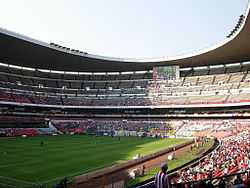Estadio Azteca
| El Coloso de Santa Úrsula | |
|
| |
 | |
| Location | Calzada de Tlalpan 3665,[1] Mexico City, Mexico |
|---|---|
| Public transit |
Estadio Azteca Xochimilco Light Rail |
| Owner | Grupo Televisa |
| Operator | Club América |
| Executive suites | 856 |
| Capacity | 95,500[2][3] |
| Record attendance |
Football: 119,853 (Mexico vs Brazil, 7 July 1968)[4] Boxing: 132,247 (Julio César Chávez vs Greg Haugen, 20 February 1993)[5] |
| Field size | 105 m × 68 m (344 ft × 223 ft) |
| Surface | Grass |
| Construction | |
| Broke ground | 1961 |
| Opened | 29 May 1966 |
| Renovated | 1986, 1999, 2013[3] |
| Construction cost | MXN$260 million |
| Architect | Pedro Ramírez Vázquez |
| Tenants | |
|
Mexico national football team (1966–present) Club América (Liga MX) (1966–present) Necaxa (1966–70 and 1982–2003) Atlante (1966–82, 1996–2001 and 2004–2007) Universidad Nacional (1967–1969) Atlético Español (1970–1982) Cruz Azul (1971–1996) American Bowl (1994, 1997–1998, and 2000–2001) NFL International Series (2005) | |
The Estadio Azteca (Spanish pronunciation: [esˈtaðjo asˈteka]) is a football stadium located in the suburb of Santa Ursula in Mexico City, Mexico. Since its opening in 1966, the stadium has been the official home stadium of the professional football team Club América and the official national stadium of the Mexico national football team. With an official capacity of 95,500,[2][3] it is the largest stadium in Mexico and the second largest soccer-specific stadium in the world, after Camp Nou.[2]
Regarded as one of the most famous and iconic football stadiums in the world,[6][7][8][9][10] it is the first to have hosted two FIFA World Cup Finals.[11] In the 1970 World Cup Final, Brazil defeated Italy 4–1 and in the 1986 World Cup Final, Argentina defeated West Germany 3–2. It also hosted the 1986 quarter-final match between Argentina and England in which Diego Maradona scored both the "Hand of God goal" and the "Goal of the Century". The stadium also hosted the "Game of the Century", when Italy defeated West Germany 4–3 in extra time in one of the 1970 semifinal matches.
The stadium was also the principal venue for the football tournament of the 1968 Summer Olympics.[12]
History

The Estadio Azteca was designed by architects Pedro Ramírez Vázquez and Rafael Mijares Alcérreca and broke ground in 1961. The inaugural match was between Club América and Torino F.C. on 29 May 1966, with a capacity for 107,494 spectators. The first goal was scored by Brazilian Arlindo Dos Santos and the second one by Brazilian José Alves "Zague"; later, the Italians tied the game, which ended in 2–2 draw. Mexican president Gustavo Díaz Ordaz made the initial kick and FIFA president Sir Stanley Rous was the witness.
A modern illumination system was inaugurated on 5 June 1966 with the first night game played between Spanish side Valencia C.F. and Necaxa. The first goal of the match was scored by Honduran José Cardona for Valencia. Roberto Martínez o Caña Brava became the first Mexican to score a goal in the stadium after scoring for Necaxa. The result was a 3–1 victory for Valencia.
In 1978 the stadium hosted the final of the Copa Interamericana between América and Boca Juniors of Argentina, and would host a final again in 1990 between América and Club Olimpia of Paraguay.
The Estadio Azteca is also the site in which Pelé and Diego Maradona (during the 1970 and 1986 FIFA World Cup) lifted the trophy for the last time (The Jules Rimet Trophy and the current FIFA World Cup Trophy, respectively).
Estadio Azteca has also been used for musical performances throughout its history. Michael Jackson (5 sold-out shows in 1993),[13] U2 (in 2006 and 2011), Luis Miguel (in 2002), Elton John, Maná, Juan Gabriel, Gloria Estefan, Jaguares, Lenny Kravitz, *Nsync, Hanson, Ana Gabriel, and The Three Tenors all have become part of the stadium's main spectacle. The stadium has also been used for political events, including Mexican president Felipe Calderón's campaign closure in 2006, as well as religious events, like the appearance of Pope John Paul II in 1999.[14]
Name

The name "Azteca" is a tribute to the Aztec heritage of Mexico City. The stadium is now owned by Mexican TV consortium Televisa. In order to avoid people associating the stadium's name with that of its rival TV Azteca, Televisa officially changed the stadium's name to Guillermo Cañedo, a top executive, long-time football advocate at Televisa and prominent member of the executive committee of FIFA. The change took place in 1997, following Cañedo's death on 20 January 1997.[15] However the change did not go well with the general population, who generally refused to refer to the stadium by its formally new name. Following a schism where two of Cañedo's sons, who worked at Televisa, switched camps and went to TV Azteca,[16] Televisa quietly returned the stadium's name to its original version. Some people did not even notice, as they usually referred to the stadium as "Azteca" during the name change.
The stadium has been given the nickname "Coloso de Santa Ursula" which in English means "Colossus of Saint Ursula", due to its large structure. Santa Ursula refers to the part of town where the stadium resides in Mexico City.[17]
Access and entrance
It is served by the Azteca station on the Xochimilco Light Rail line. This line is an extension of the Mexico City metro system which begins at Metro Tasqueña station and ends in the Xochimilco Light Rail Station.
Tickets are available, up to kick-off times, from the ticket office which is located at the front of the stadium, just down the exit ramps from the Azteca station. Tickets start from as little as 100 pesos (9 U.S. Dollars as of 2013). For bigger matches such as Club América's games against Chivas de Guadalajara, Cruz Azul and UNAM Pumas where sellouts are common, numerous touts circulate offering tickets at competitive prices.

Monuments and memorials

A commemorative bronze plaque of the "Game of the Century" played between Italy and West Germany, as well as Diego Maradona's "Goal of the Century" against England.
There is also a commemorative plaque with the names of the first goal scorer in the inaugural match and in the first match played at night.
Notable events

Estadio Azteca has hosted a variety of international sporting competitions, including:
Football
- 1968 Summer Olympics
- 1970 FIFA World Cup
- 1975 Pan American Games
- 1983 FIFA World Youth Championship
- 1986 FIFA World Cup
- 1993 CONCACAF Gold Cup
- 1999 FIFA Confederations Cup
- 2003 CONCACAF Gold Cup
- 2011 FIFA U-17 World Cup
Boxing and American Football
- On 20 February 1993, Julio César Chávez fought Greg Haugen in front of 132,247 spectators.
- On 2 October 2005, the first international regular-season game in the history of the NFL was played in the stadium between the San Francisco 49ers and the Arizona Cardinals. The game was a 31–14 victory for the Cardinals and held the record of the largest crowd to attend a regular season NFL game with 103,467.
Concerts
- In October and November 1993, Michael Jackson finished the Dangerous World Tour with five sold out shows at this stadium, for a total of 500,000 people (circa 100,000 per show, more than any other artist or band, Mexican or International).
- On 14 May 2011, Irish rock band U2 presented the 360° Tour scoring the most-attended concert on the tour with a total attendance of 110,000 people.
- On 8 May 2012, Paul McCartney performed at the Estadio Azteca for the first time in his career, in a non-sold-out concert for 53,000 people. One of these shows was broadcast by Televisa(Canal 2).[18]
Funeral services
- The funeral of fellow Mexican comedian Chespirito was held on November 30, 2014.
See also
References
- ↑ http://www.worldofstadiums.com/north-america/mexico/estadio-azteca/
- ↑ 2.0 2.1 2.2 "Mexico: Azteca up for revamp, capacity falls". stadiumdb.com. 2015-02-22. Retrieved 2015-04-25.
- ↑ 3.0 3.1 3.2 "Estadio Azteca". stadiumdb.com. Retrieved 2015-04-25.
- ↑ "El Monumental le gana a la Bombonera como estadio más emblemático". 12 April 2013.
- ↑ "StadiumDB: Estadio Azteca". Retrieved 5 September 2013.
- ↑ "Ranking the Top 10 Most Iconic Stadiums in World Football". Bleacherreport. Retrieved 5 April 2013.
- ↑ "Classic Stadium: Estadio Azteca". FIFA.com.
- ↑ Smart, Tony. "10 of the world's best sports venues". CNN. Retrieved 9 March 2012.
- ↑ Wilson, Steve. "World Soccer Stadiums". ESPN. Retrieved 4 June 2007.
- ↑ Gordon, Aaron. "Mexico wins Mexican-American stadium war". Buzzfeed. Retrieved 9 April 2013.
- ↑ "Mexico's historical stadium". FIFA.com. Retrieved 31 May 2012.
- ↑ 1968 Summer Olympics official report. Volume 2. Part 1. pp. 78–79.
- ↑ "Cronología Estadio Azteca". Retrieved 2007-09-13.
- ↑ "Pide Juan Pablo II "superar" deficiencias en el progreso social". Retrieved 2007-10-12.
- ↑ "FIFA Senior Vice President Guillermo Cañedo has died". FIFA.com. Retrieved 21 January 1997. Check date values in:
|accessdate=(help) - ↑ Martínez, César. "Cañedo Whites go to TV Azteca". La Jornada. Retrieved 13 September 2007.
- ↑ Rai, Asha (14 March 2014). "Estadio Azteca: Seasons in the Sun". The Times of India. Retrieved 17 March 2014.
- ↑ http://www.webcitation.org/query?id=1339676569778155&date=@0&fromform=1
Further reading
- "Magical memories live on in the vaunted Azteca" - fifaworldcup.com - FIFA
External links
| Wikimedia Commons has media related to Estadio Azteca. |
Coordinates: 19°18′10.48″N 99°9′1.59″W / 19.3029111°N 99.1504417°W
| Preceded by National Stadium Tokyo |
Summer Olympics Football Men's Finals (Estadio Azteca) 1968 |
Succeeded by Olympiastadion Munich |
| Preceded by Wembley Stadium London |
FIFA World Cup Final Venue 1970 |
Succeeded by Olympiastadion Munich |
| Preceded by Santiago Bernabéu Madrid |
FIFA World Cup Final Venue 1986 |
Succeeded by Stadio Olimpico Rome |
| Preceded by Los Angeles Memorial Coliseum Los Angeles |
CONCACAF Gold Cup Final Venue 1993 |
Succeeded by Los Angeles Memorial Coliseum Los Angeles |
| Preceded by King Fahd II Stadium Riyadh |
FIFA Confederations Cup Final Venue 1999 |
Succeeded by International Stadium Yokohama Yokohama |
| Preceded by Rose Bowl Pasadena |
CONCACAF Gold Cup Final Venue 2003 |
Succeeded by Giants Stadium East Rutherford |
| Preceded by first venue |
National Football League Host stadium of international regular season game San Francisco 49ers v. Arizona Cardinals 2 October 2005 |
Succeeded by Wembley Stadium, London, England New York Giants v. Miami Dolphins 28 October 2007 |
| ||||||||||||||||||||||||||||||||||||||||||
| ||||||||
| ||||||
| ||||||
| ||||||
